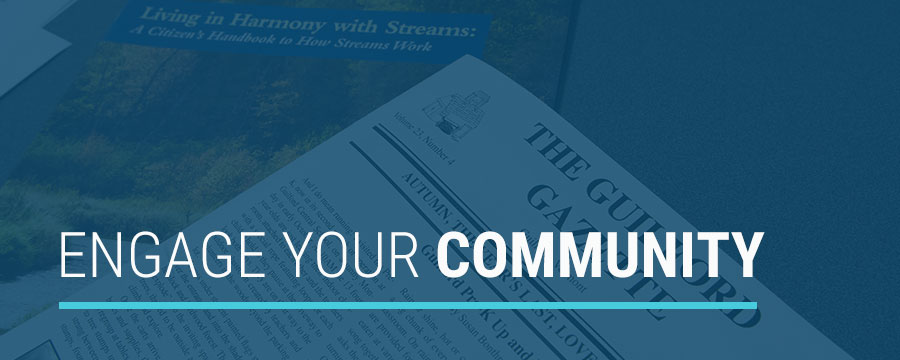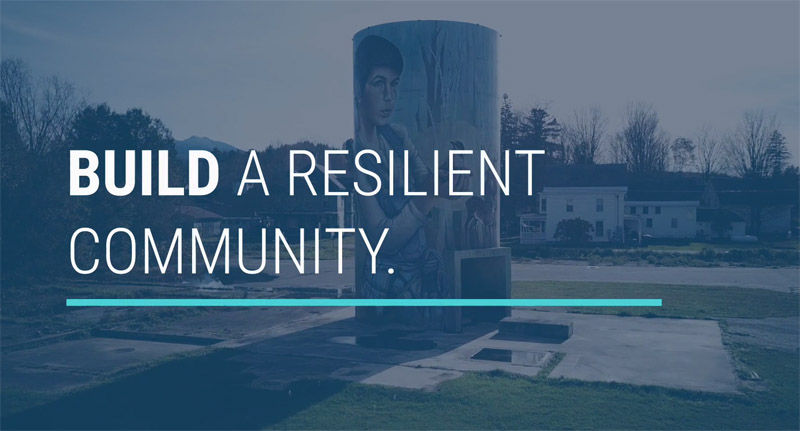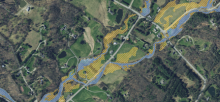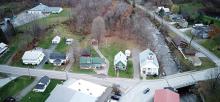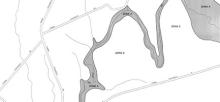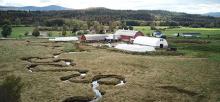Across the state, Vermonters like you are protecting their communities from flood damage. Once you’ve got a good understanding of the risks your community faces and the opportunities to reduce those risks, it’s time to bring your neighbors on board. Helping people make informed decisions will take time and persistence. Adopting a new bylaw or taking on a mitigation project may require several community and one-on-one meetings that play out over multiple years. But it’s worth it. And there are several examples around the state that you can learn from. Review the case studies in this training series for more ideas.
To succeed, you don’t need all of your residents to become flood resiliency fans. Just provide a clear picture of what your community faces and focus on getting across the concept of no adverse impact: that any new development shouldn’t put other property owners or the town at greater risk of flood damage. If they at least understand what kind of development is risky to themselves, their neighbors, and the town budget in the event of a disaster, you may set the stage for a bylaw update that makes your community safer or a mitigation project that removes or reduces current hazards your community faces.
Ensuring that existing buildings, roads, and bridges in your community aren’t put at greater risk is sometimes in conflict with personal development goals of landowners. Everyone won’t always see eye to eye on priorities when development limits are proposed. If you can listen to landowners’ concerns you may be able to help them find a solution that both fits their needs and leaves room for the river or stream.
In your work to protect your community, learn how rivers work so you can be confident in what you’re talking about, find several ways to get the facts out to your residents, make yourself accessible by publishing your contact information at the Clerk’s office and on the town website and offering site visits, listen to community concerns and look for ways to help people meet their needs without increasing risk, and bring in help from your Regional Planning Commission and your Regional Floodplain Manager to assist with any questions you can’t answer.
Below, you’ll find resources to get you up to speed, templates and handouts to get the word out, and communication strategies.
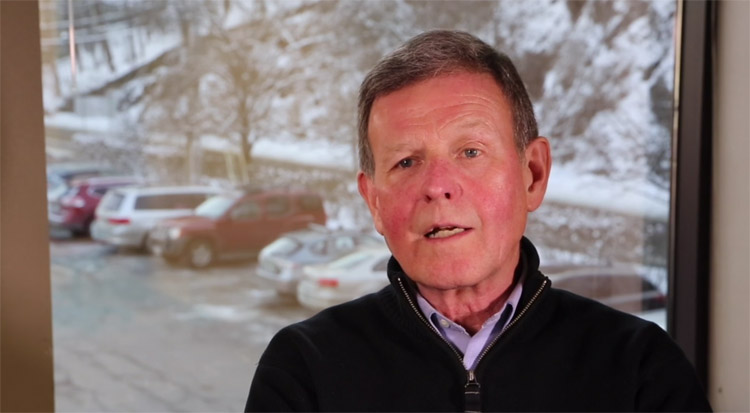
Hear an extended interview with Steve Lembke, Floodplain Administrator in Guilford, talking about his process in getting up to speed and embarking upon a River Corridor Bylaw update.
"Don’t tell people what they have to do and should do. Just share the information and ask ‘What would make sense to do here?’ The residents will come up with the solutions. And then you haven’t done something to them, you’ve done something for them."
Sections on this page:
Learn How Rivers Work

To help your neighbors make room for rivers, you need to be able to explain how rivers and streams function over time and during flooding events. Every situation is unique and when you understand what water is likely to do, you’ll be able to give your town and residents good advice about what is safe and what is risky. There’s plenty of reading, but you’ll also want to spend some time getting to know your Regional Floodplain Manager who can talk through concepts and how they apply to your town. Use these resources to get up to speed:
-
Making Room for Rivers - this training module series (you’re reading part of it right now!) provides background information to help you understand the key issues of River Corridor and floodplain protection, learning opportunities from the work other communities are doing, and in-depth assistance to help you get to work.
-
Your Regional Floodplain Manager - your partner in this work and finding the answers you need.
-
Your Regional Planning Commission - help with plan updates, maps, studies, and finding funding.
-
Flood Ready Vermont - the primary website to help you with this project including an extensive list of resource links, specific resources for Municipal Administrative Officials, and specific resources for Planning Commissions and Municipal Officials
-
Flood Resilience Listserve - learn from peers and share your questions, challenges, and successes.
-
Community Risk Report - details on what your town has already done and what more you could do.
-
The Flood Ready Atlas - mapping all River Corridors in Vermont and some of the floodplains and floodways.
-
FEMA Flood Insurance Rate Maps (FIRM) - mapping resources when the Flood Ready Atlas doesn’t have what you need.
-
The National Flood Insurance Program (NFIP) guidelines - what your community must do to remain in the NFIP program, allowing any resident to purchase flood insurance.
-
Additional reading resources, such as:
-
Examples from work in other communities
-
Your Neighbors - residents in your community who have experienced flooding may be able to provide a helpful account of what water typically does at a location.
A Process to Follow
Helping Decision Makers Commit to Consider Protection
Once you’ve got an initial grasp of how rivers and streams work in your community and the opportunities to reduce risk, it’s time to figure out if the decision makers are willing to take action. In many cases, that’s your selectboard or city council. Start by determining whether or not they’re interested in getting all of their plans (Municipal/Town Plan, Emergency Operations Plan, Hazard Mitigation Plan, Road & Bridge Standards) up to date and considering a bylaw update to protect River Corridors. Your Regional Floodplain Manager can help you provide accurate information and answers to their questions. The community risk report can be helpful in reaching a shared understanding of available opportunities and the model plans and regulations can provide a helpful start for considering what to tackle. Often, the Emergency Relief and Assistance Fund is a compelling reason for town officials to consider keeping plans up to date and adopting a River Corridor protection bylaw. If decision makers are uncertain, you’ll need to focus on their constituents and build enough knowledge and awareness to convince them it’s worth investigating.
Engaging the Community During the Consideration Process
When the decision makers are willing to consider taking action, it’s time to provide them with as much information as they need to build their own confidence in determining what will be right for the community. Your Regional Floodplain Manager could help you and the decision makers identify options. Once you have an idea of what’s on the table, it’s time to take it to your residents. Bring information about your River Corridors and floodplains, along with any specific plans your community is considering to places where people are. Use any way you can think of to get the facts out so that residents understand the facts. There are several suggestions and tools in the next section.
You’ll need to host meetings to allow for a public conversation in your community where you can ensure people get accurate information. Consider an initial meeting where people can learn about the basic concepts, possibly with help from your Regional Floodplain Manager, and simply express their hopes and concerns and know they are heard, saving any discussion of solutions for a later meeting. Figure out what different perspectives exist and do what you can to have people holding those various perspectives involved at each meeting and on any committees that are set up. Avoid accidentally or intentionally excluding a perspective that might otherwise come up late in the process and derail it. There is help for hosting these meetings and presenting the risks and opportunities. Use your Regional Planning Commission and your Regional Floodplain Manager. Find more ideas on types of meetings in the next section.
"In my experience as a professional community planner, the best thing to do when there’s a divisive issue is to get people together in a room who have differing ideas and just start talking about it. One ground rule we suggest is that the first couple of meetings are all about sharing ideas, not debating ideas. So that means anything we put on the table, we take the notes and we leave the discussion of merit till later." - Seth Jensen, Principal Planner at Lamoille County Planning Commission.
Explaining Changes to Impacted Residents
If your community adopts new rules or takes on a project, it’s just as important to inform residents about what this means after the decision as it was before. Use the same tools to explain what has changed for impacted residents. Think about who might interact with them at key decision points, such as the town clerk, a selectboard member, local contractors or surveyors. Make sure people in those roles are aware of the changes so that they provide residents helpful advice.
If you had a successful outreach process, document what worked well and what could have been improved so you’re ready to do it even better the next time around. Then, it’s time to consider what the next project might be for your community to reduce risk of flood damage.
Get the Facts Out
Unless your community has just suffered significant flood damage, chances are that your neighbors aren’t already thinking about flood risks and why making room for rivers is important. You’ll need to bring the facts and opportunities to them, make the information easy to digest, and try multiple formats to reach as many different learning styles as you can. There are several handouts and engagement templates that you can customize.
Strategies
Share information about the opportunities for protecting rivers and streams in as many places as possible. Meeting with people in person is ideal, but you likely won’t have time to meet with everyone. Using these strategies, and the customizable template tools in the next section, can help you reach your residents. Start by watching how several people around the state work to get the word out.
It’s a case of persistence. Find the people where they are. Go have a conversation in the local restaurant with a morning coffee club or at the bar with somebody. Really try to reach out and get folks engaged because unless people are engaged with it, it’s not going to be successful. - Charlie Hancock, Chairman, Montgomery Selectboard
Meetings & Events
Talking in person is a great way to hear common concerns and clear up any confusion. Look for opportunities where community members are already coming together. Your Selectboard or City Council meeting may be the most important opportunity to make a presentation and have a discussion with your Regional Floodplain Manager, your Regional Planning Commission, and fellow residents. Invite any relevant community partners, such as watershed groups and land trusts.
Think about other gatherings, like pancake breakfasts, clubs, parks, town meeting, festivals, grocery and hardware stores, schools, or the bar. At any of these venues, you could set up a panel or discussion or simply have a table with someone to provide residents helpful information about the relationship between their property and water. If there are people in the community who hold relevant positions and can speak to the benefits that come from making room for rivers and streams, such as your road supervisor or planning/conservation commissioners, invite them to co-present with you.
A great way to share how rivers work is the flume. People can quickly see how meanders form, banks are lost to erosion, riprap changes the power of water, and flooding impacts the landscape. Your Regional Floodplain Manager can help you get a flume demonstration at your local event. It’s always a crowd pleaser.
Additional strategies for getting people together include:
- A design charrette led by your Regional Planning Commission. They can facilitate a listening and visioning session to help draw out questions and ideas that can be integrated into plans.
- A River Corridor and floodplain field trip. Work with your local river scientist, engineers, and other relevant community partners to get a tour of areas at risk and understand first hand what can be done. Your Regional Floodplain Manager can help bring these experts together.
- A river clean up or celebration event. Call attention to the value that an undeveloped River Corridor or floodplain is providing for your community by having a party there (on a dry day!). Bring maps that help people understand where these assets are and what they protect.
- A public hearing to allow people to ask questions and present concerns and hopes. This is a great opportunity to present the facts to the community and hear questions so that you can find the answers for them.
- A plan presentation to share with the community details about any plan updates that are adopted. Work with those involved in building the plan to create a presentation and invite everyone who is likely to need to know about any new requirements.
Newspapers
Use your community newspaper to share facts about your rivers and streams and the opportunities your community has to decrease risk. You might consider a series of articles that present history, current challenges, opportunities, what other communities have done, and next steps. Work with your paper to determine what kind of content you can contribute. They may decide to report on it, run a story that you write for them, or provide opportunities for you to write a letter. Always be clear where readers can learn more and how to reach you with questions. Use the newspaper template associated with this module to help with a story. Then, consider what items in the Learn About Rivers section above were most helpful to you and adapt them for your paper.
Finally, make sure to advertise all upcoming events in the newspaper.
Digital Media
Some of your residents don’t read the newspaper and don’t show up regularly to public events. You might be able to reach them online. Put information on your town website with details about what is being considered. You might draft a Frequently Asked Questions section, adapted from the Flood Ready site. Then, think of other websites, e-newsletters, or social media accounts for your community that you can use to notify residents about this. Reach out to the people who manage these sites to see if they will link to the town webpage.
Just like a newspaper, you can use Front Porch Forum or local town listservs or websites to share important information about events and the opportunities. These are great tools for getting the word out, building support, and getting people out to events.
It’s unlikely that setting up a social media account specifically for this purpose is worthwhile, given that building a solid following could take a large investment of time. Look for any existing relevant social media accounts, such as town Facebook or Twitter accounts, that might allow you to contribute content. Post information you found helpful in your own learning process. Keep it very short and link to interesting information, like helpful PDFs, videos, photos of risky local areas, flooding photos or videos, or your Community Risk Assessment. Share opportunities and events through Facebook and Twitter, using community accounts, community partner accounts, and your personal accounts. Creating and sharing an event on Facebook can be very helpful in letting people know about it. They can receive invitations from their friends, invite their friends, and see who has indicated that they’re going.
If social media is not your thing, find someone who is comfortable with it and ask them to help you out.
Handouts & Flyers
Several of the templates associated with this module (see next section) give you easy, adaptable printed materials. Consider mailing a postcard to everyone impacted by any new regulations. Your Regional Planning Commission can help you identify street addresses in the hazard areas. Post cards are inexpensive and great for simply inviting people to a meeting to learn more.
The flyers and handouts are great for any events, but you should also consider putting them in public places where people can pick them up, such as the Clerk’s office, library, stores, cafes and coffee shops, bars, or anywhere else you can think people may frequent.
In addition to the templates, you might also find these useful:
- Introductions to get people thinking about getting Flood Ready, and a PDF with the information at the beginning of this training.
- Handouts about River Corridors, floodplains, insurance, safety, and mapping.
- Quick guides for technical solutions to floodproofing, debris management, reducing stormwater runoff, protecting River Corridors and floodplains, planning, and preparation.
Templates You Can Customize
 PowerPoint Presentations
PowerPoint Presentations
Use this Power Point template to create your own presentation. Ask your Regional Floodplain Manager for assistance with the content. They can also come and present or assist you with a presentation.
Event Announcement Flyer
Use this Word template to let residents know about upcoming events where they can learn more about how to make room for rivers. This includes an illustration that you could use, replace, or simply remove.
Postcard
Reach landowners affected by any proposed bylaw update to ensure they are aware that this could impact them and that they have the opportunity to learn more about it and participate. Use a template with an image on one side and text on the other or one with only text.
Find Location on the Atlas
Help residents understand where the River Corridor and Special Flood Hazard Areas are with a detailed guide on how to use the atlas in PDF or Word for you to edit.
Newspaper Article
Provide your local newspaper with an update on the process and the opportunities in making room for rivers. This Word document has an article that was written for the Guilford Gazette during their River Corridor Bylaw adoption process but could be adapted to any other issue.
More
We've added more templates on our No Adverse Impact page to inform residents about the bylaw process or after bylaws have been adopted.
Share What Works
Did you find a successful strategy that isn’t covered here? Tell us about it and we’ll consider adding it in for other communities to repurpose! If you adapted one of our templates or created a great event, we’d love to hear about it. Thanks!

Reflection Questions
- What do you need to read and who do you need to talk with to feel confident in understanding how rivers and streams work?
- How can you make sure every resident can easily find your contact information to ask questions about this work?
- What process will you use to reduce risk in your community?
- What will effectively engage your residents in the process? What resources do you need to do this?
- How will you work with residents who do not want anything to change?


